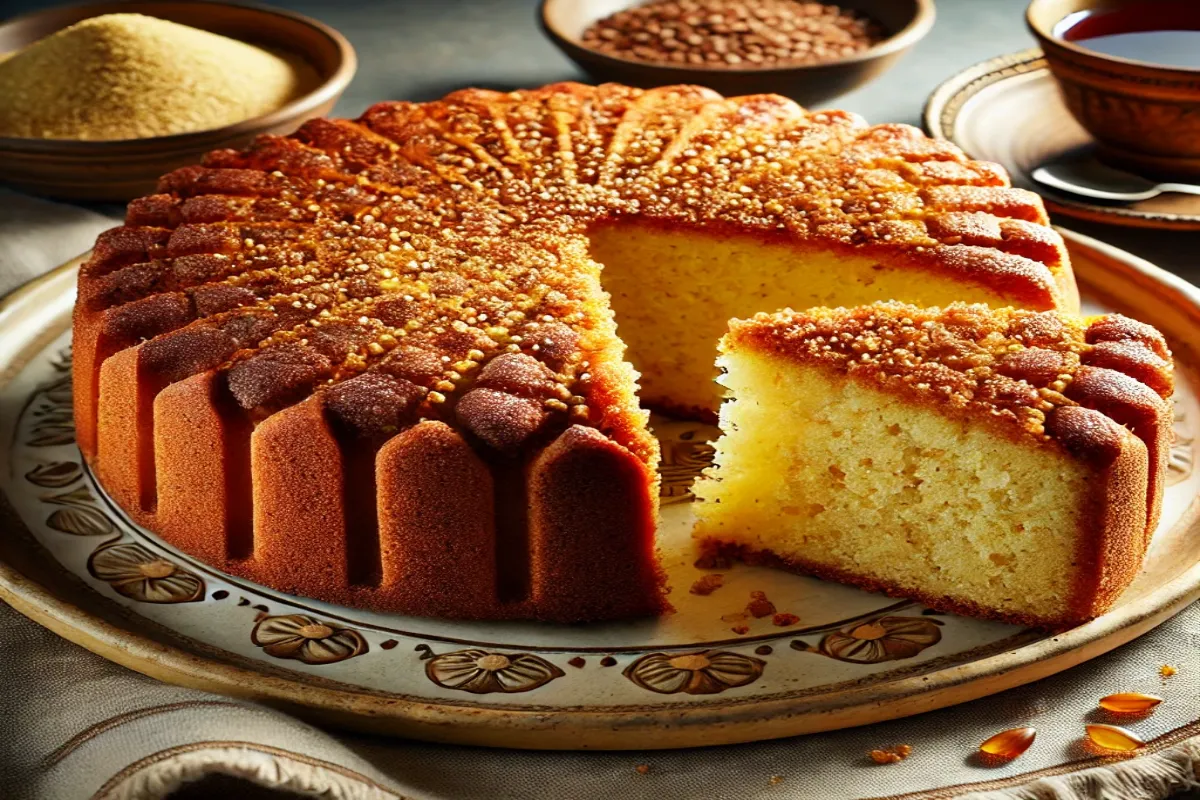When we think of semolina flour, pasta and pizza dough often come to mind. Traditionally, bakers use semolina in savory dishes, but this versatile flour also works well in cakes. Semolina flour has a distinct texture, flavor, and high protein content that can elevate your cake recipes in unexpected ways. In this article, we will explore the benefits, challenges, and best practices for using semolina flour in cakes, along with specific tips and recipes.
What is Semolina Flour?
Semolina flour is made from coarsely ground durum wheat, known for its hard texture and high gluten content. It’s the same flour used to make traditional pasta and certain types of bread. Unlike the finely ground all-purpose flour, semolina is grainier, giving it a distinct texture. This makes it excellent for a range of baking applications, including cakes.
Semolina is one of the most versatile flours in the world of baking. According to King Arthur Baking, semolina flour is prized for its nutty flavor and beautiful golden color, adding depth to baked goods beyond pasta and bread. It is also used in various culinary traditions for different types of cakes and desserts, giving a unique texture and flavor to your baked creations.
Semolina Flour vs. All-Purpose Flour in Cakes
One of the common questions among bakers is whether semolina flour is better than all-purpose flour for cakes. The answer largely depends on the type of cake you’re making. Semolina flour has a higher protein content than all-purpose flour, which means it forms more gluten when mixed with liquids. This makes semolina flour an excellent choice for cakes that benefit from a dense, chewy texture. On the other hand, all-purpose flour is more versatile and can be used for a wider variety of cakes, including lighter and airier ones like chiffon or sponge cakes.
However, semolina flour offers unique benefits. It creates a slightly coarse crumb, which can give your cakes an interesting texture, almost like a cornbread but more refined. The nutty flavor of semolina also adds depth to cakes, making them taste more complex and rich. For instance, Middle Eastern desserts like basbousa, a semolina-based cake soaked in sweet syrup, heavily rely on semolina flour to create their characteristic texture.
If you’re interested in a detailed guide on baking with semolina, the Ultimate Semolina Cake Guide offers step-by-step tips and techniques to help you perfect your semolina-based cakes.
Texture and Flavor Benefits of Semolina Flour in Cakes
Using semolina flour in cakes introduces a unique crumb texture and a slightly nutty flavor that sets it apart from cakes made with traditional flour. Unlike all-purpose flour, semolina’s coarse grind gives cakes a heartier texture, making it perfect for recipes that benefit from a bit of chewiness and added structure. If you prefer your cakes with more texture, semolina flour can be a great addition to your recipes.
Moisture Retention and Longevity
One of the biggest advantages of using semolina flour in cakes is its ability to retain moisture. Cakes made with semolina tend to stay moist for longer periods, which is why it’s often used in syrup-soaked cakes like basbousa or revani, a popular dessert in Turkey and Greece. This quality makes semolina flour ideal for cakes that need to stay fresh over several days, making it perfect for special occasions or events where cakes need to be prepared ahead of time.
Moreover, semolina flour helps cakes retain moisture better, leading to longer-lasting baked goods. This is why semolina is often used in desserts like basbousa and Sooji Ka Halwa, both of which are known for their rich, moist textures. You can find more expert advice on baking with semolina flour at Serious Eats.
Substituting Semolina Flour in Cake Recipes
If you’re looking to add a twist to your favorite cake recipe, you can substitute semolina flour for a portion of the all-purpose flour. A common approach is to replace about 25% of the flour with semolina to maintain balance in the recipe. This will ensure your cake gains the textural benefits of semolina without becoming too dense. However, in some recipes, semolina can be used as the primary flour, especially in traditional Middle Eastern and Mediterranean cakes.
Tips for Substituting Semolina Flour
- Start small: Begin by replacing 25% of the all-purpose flour with semolina and adjust from there based on the results. This small substitution will provide you with the benefits of semolina without drastically changing the cake’s structure.
- Pair with moist ingredients: Since semolina can be coarse, combining it with ingredients like yogurt or buttermilk can help maintain moisture in the cake. These ingredients work well with semolina flour to produce cakes that are rich, moist, and tender.
- Use in syrup-soaked cakes: Semolina flour excels in cakes that require a syrup-soaked finish. The coarse texture absorbs the syrup well, resulting in a cake that is flavorful and moist.
For more details on the impact of semolina in baking, explore this article on what does semolina do in baking.
Popular Cakes Made with Semolina Flour

Several delicious cakes rely on semolina flour as a key ingredient. These cakes often come from regions where semolina is a staple ingredient, such as the Mediterranean, Middle East, and India.
1. Basbousa
Basbousa is a traditional Middle Eastern semolina cake that is soaked in a sweet syrup, often flavored with rose water or orange blossom water. The cake has a unique, grainy texture thanks to the semolina flour and is incredibly moist due to the syrup. This dessert is a staple at celebrations and special occasions in countries like Egypt, Lebanon, and Syria. The semolina flour gives it a distinct bite and holds up well to the syrup, making it an ideal choice for this kind of dessert.
2. Sooji Ka Halwa
Sooji Ka Halwa is an Indian semolina dessert that is often served during religious ceremonies and festivals. It is made by roasting semolina in ghee (clarified butter) and then cooking it with water, sugar, and cardamom. The result is a rich, dense, and fragrant pudding-like dessert that is deeply satisfying. In this recipe, semolina flour plays a crucial role in providing texture and flavor.
3. Revani
Revani is a Greek and Turkish semolina cake that is also soaked in syrup, similar to basbousa. However, revani often includes yogurt in the batter, which adds a slight tang and enhances the cake’s moisture. This cake is typically flavored with lemon or orange zest and is topped with ground nuts, adding an extra layer of flavor and texture.
4. Semolina Almond Cake
This Mediterranean-inspired cake combines the nutty flavor of semolina with the richness of almonds. The semolina gives the cake a dense, moist crumb, while the almonds add a subtle flavor and crunch. This cake is perfect for those who enjoy desserts that aren’t overly sweet but still pack a punch in terms of flavor and texture.
5. Lemon Semolina Cake
This bright and zesty cake pairs the slightly coarse texture of semolina with the freshness of lemon. The result is a cake that is both hearty and refreshing, making it a great choice for spring and summer gatherings. The semolina flour helps the cake maintain its structure, while the lemon adds a burst of flavor that balances the richness of the cake.
6. Qatayef
Qatayef is a traditional Middle Eastern dessert often made during Ramadan. It consists of small, pancake-like cakes filled with sweetened cheese or nuts and then deep-fried or baked. The dough for qatayef often includes semolina, which gives the pancakes a slightly chewy texture that holds up well to the filling. The semolina flour adds structure to the batter, ensuring that the pancakes don’t fall apart when filled and cooked.
Potential Drawbacks of Using Semolina Flour in Cakes

While semolina flour offers many benefits, it also comes with some challenges. The coarser texture can lead to a denser, heavier cake if not used in the right proportions. This may not be ideal for recipes that require a light and fluffy texture, like a sponge cake. When using semolina flour, it’s essential to balance it with other ingredients to ensure the cake remains tender and moist.
Gluten Content
Semolina flour is high in gluten, which might not be suitable for those with gluten sensitivities or celiac disease. If you are baking for someone who requires a gluten-free diet, you’ll need to explore alternative flours that can mimic the structure and moisture retention that semolina provides. There are gluten-free substitutes available, such as rice flour or a gluten-free flour blend, but these may require additional adjustments to the recipe to achieve the desired texture and flavor.
Coarse Texture
The coarse nature of semolina flour can sometimes be too much for certain cake recipes, particularly those that require a delicate crumb. In these cases, it’s best to use semolina in combination with finer flours, such as all-purpose or cake flour, to achieve the right balance. Semolina flour is excellent for rustic cakes and desserts but may not be the best choice for every type of cake.
Best Practices for Baking Cakes with Semolina Flour
Here are a few tips to keep in mind when using semolina flour in your cake recipes:
- Use it in combination with other flours: As mentioned, substituting around 25% of the all-purpose flour with semolina can give you the benefits of both flours without compromising texture.
- Pair with moist ingredients: Since semolina can be coarse, combining it with ingredients like yogurt or buttermilk can help maintain moisture in the cake. These ingredients work well with semolina flour to produce cakes that are rich, moist, and tender.
- Experiment with cultural recipes: Many traditional recipes from the Middle East and South Asia make excellent use of semolina flour in cakes and desserts. These recipes often highlight semolina’s ability to retain moisture and add texture. Trying out these recipes can help you better understand how semolina works in baking and inspire you to incorporate it into your own creations.
Other Baked Goods Using Semolina Flour
Besides cakes, semolina flour is commonly used in various baked goods, such as bread, biscuits, and pastries. The coarser texture of semolina helps create a chewy and hearty texture, making it ideal for rustic bread like baguettes or even English muffins.
Semolina also shines in traditional recipes such as Qatayef (sweet filled semolina pancakes) and Sooji Ka Halwa (semolina pudding). These desserts use semolina to achieve a specific texture that’s both satisfying and unique.
For more inspiration, take a look at this guide on the best cheese for bread, which pairs well with semolina-based bread recipes.
FAQs
Is semolina flour better than all-purpose flour for cakes?
It depends on the type of cake. For cakes that benefit from a chewy texture and rich flavor, semolina flour can be a great addition. However, it may not be ideal for lighter cakes like sponges or chiffon.
Can you use semolina flour instead of flour in cakes?
Yes, but it’s recommended to replace only a portion of the all-purpose flour with semolina to maintain the cake’s balance of texture and structure.
What is the best substitute for semolina flour in baking?
If you don’t have semolina flour on hand, bread flour is the closest substitute due to its higher protein content. All-purpose flour can also work in a pinch, though it will result in a slightly different texture.
Does semolina flour make cakes taste different?
Yes, semolina adds a nutty flavor and a slightly coarser texture, making cakes taste richer and more complex.
Conclusion
Semolina flour offers a unique twist on traditional cakes, adding a new dimension to both flavor and texture. While it might not be suitable for every type of cake, its ability to retain moisture and create a distinct crumb makes it worth experimenting with. So, whether you’re baking a classic Middle Eastern dessert or adding a modern twist to a traditional cake recipe, semolina flour is an ingredient worth exploring in your kitchen.

